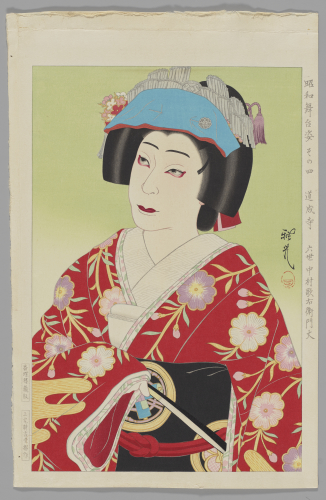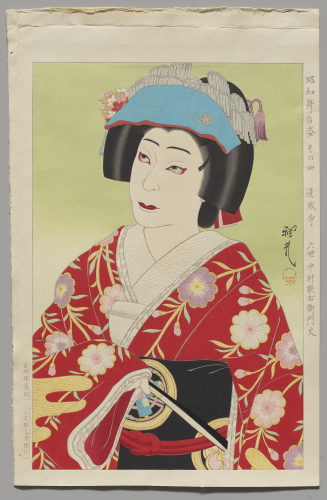Nakamura Utaemon VI as Kiyohime in ‘Musume Dôjôji’

Ōta Masamitsu, Nakamura Utaemon VI as Kiyohime in ‘Musume Dôjôji’, 1955, color woodblock print on paper, Gift of Mrs. Fay Kramer, © unknown, research required, 91.48.2D

This work is not currently on view.
- Title
Nakamura Utaemon VI as Kiyohime in ‘Musume Dôjôji’
- Related Titles
series title: Showa butai sugata (Figures of the Showa Stage)
- Artist
- Related People
- Date
1955
- Period
Japan: Shōwa period (1926-1989)
- Medium
color woodblock print on paper
- Dimensions (H x W x D)
image: 14 1/4 in x 9 1/2 in; sheet: 16 5/16 in x 10 11/16 in
- Collection Area
Asian Art; Graphic Arts
- Category
Prints
Japanese Modern Prints
- Object Type
relief print
- Culture
Japanese
- Credit Line
Gift of Mrs. Fay Kramer
- Accession Number
91.48.2D
- Copyright
© unknown, research required
- Terms
One of the greatest dance roles in kabuki is that of Princess Kiyo in “Musume Dôjôji.” An ancient legend immortalized first in the Noh drama and later in kabuki, it concerns unrequited love between the maiden Kiyo and Anchin, a novice Buddhist monk at Dôjôji temple. Anchin repeatedly tried to persuade Kiyo to forget him, but she pursued him relentlessly. In desperation, he hid beneath the temple bell. Kiyo follows him into the temple grounds and performs a passionate dance, finally turning into a fire-breathing serpent that embraces the bell, melting it and killing Anchin. This print depicts the famous 20th-century onnagata Nakamura Utaemon VI in the role of Kiyo.









